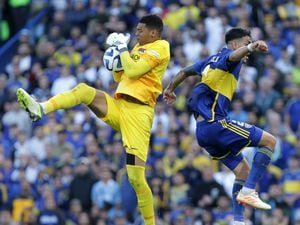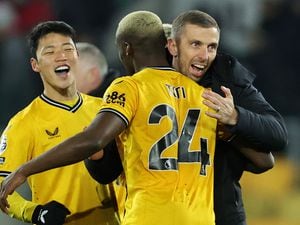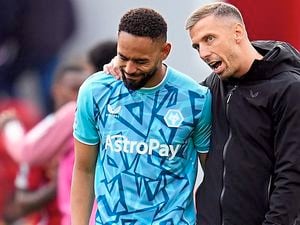Sky Sports' Johnny Phillips: Wolves were in safe hands with Rui Patricio
Rui Patricio’s departure to AS Roma this week brought to a close the career of a Wolves goalkeeping great.
Bert Williams will always be the benchmark from the golden era, but in the 50 years since Phil Parkes’ top level consistency established him as the club’s number one for much of the 70s, Wolves have rarely struggled to fill the gap between the sticks.
Parkes was a key part of a team that reached the 1972 Uefa Cup final and qualified for Europe on three occasions. Yet he missed out on the only piece of silverware during that period, when he was injured for the 1974 League Cup final, with deputy Gary Pierce having the match of his life as Wolves defeated Manchester City. By the time of the next – and last – major trophy to come the club’s way Parkes was long gone.
Paul Bradshaw was part of the side who defeated European champions Nottingham Forest at Wembley in the 1980 League Cup final, making 243 appearances and twice winning the club’s player of the year award. Those who saw him play speak of a solid and reliable, rather than spectacular, player who was kept busier than he should have been by an ageing team.
As Wolves lurched towards oblivion during the mid-80s they still managed to source good keepers, including the madcap John Burridge and then Tim Flowers, who went on to win the Premier League with Blackburn Rovers and become an England international.
It was Mark Kendall who helped lift Wolves from the depths, establishing himself as first choice during the late 1980s revival. The former Spurs man was far too good for the Fourth Division and became a cult hero during his time, or at least his backside did.

Kendall’s successor, Mike Stowell, became the main man of the 90s. Stowell was a superb keeper at Championship level and became a crowd favourite, competing with Welsh international Paul Jones for much of his time at Molineux. There were also two short-term replacements in that era for FA Cup ties which fans recall for different reasons. When both Stowell and Jones were unavailable for a fourth round tie against Bolton Wanderers, manager Graham Turner signed Dave Beasant on-loan from Chelsea. The England international was at fault for both goals in a shambolic 2-0 home defeat. Then, in March 1998, another former Wimbledon man, Hans Segers, made a far more favourable impression saving a last-minute penalty from Jimmy Floyd Hasselbaink to secure a famous quarter-final win at Leeds.
The 2000s belonged to Matt Murray and Wayne Hennessey. On the occasions the pair were both fit they represented the strongest duo the club has ever had at one time. Murray was arguably the most complete goalkeeper to ever represent the club, and only injuries denied him from fulfilling his potential. An unbelievable short-range stopper, he had great reach for the longer shots. His distribution was also outstanding, as illustrated by the throw-out which landed in the opposition half starting the move which Mark Kennedy finished for one of the goals of the decade against Newcastle in the FA Cup third round in January 2003.
Hennessey also had great distribution, particularly off the deck, and went on to become a very successful Premier League keeper as well as helping Wales to the semi-finals of Euro 2016.
When Wolves fell on hard times a long-serving keeper stepped up. Carl Ikeme waited eight years to establish himself as the club’s number one and became a dependable figure on the pitch and calming influence in the dressing room during Kenny Jackett’s revival. In the 2013/14 season his 22 clean sheets deservedly earned him a place in the PFA League One Team of the Year. Only the cruel leukaemia diagnosis denied Ikeme a chance to prove himself under Nuno Espirito Santo.
John Ruddy’s only season as first choice ended with a Championship winners’ medal before Nuno turned to the 30-year old Portuguese number one. The £16million fee paid to Sporting Lisbon raised some eyebrows but Patricio quickly illustrated why he was worth the money. It was not just the variety of saves he was capable of; a fingertip intervention from Raheem Sterling’s top corner-bound thunderbolt stands out as much as the quick feet that kept out Gabriel Jesus’s header from six yards in the same game when Wolves held champions Manchester City at Molineux in only Patricio’s second Molineux appearance. He was a formidable opponent when faced with one-on-ones, unfazed by the pedigree of whichever forward was through on his goal.

Where Patricio really excelled was in the more routine areas of the game. Those aspects of goalkeeping that some make look scrappy, ugly or uncertain. The job can be as much about imposing oneself on the opposition as making saves. There was no palaver with Patricio when it came to hoovering up danger. He made himself known when the penalty area got cluttered, dominating proceedings and ensuring there would never be a melee exploited by eager strikers. That presence and authority will be missed. Over three of Wolves’ best seasons in more than a generation, Patricio excelled.
It has not always been plain sailing. In July 1986, a non-league keeper by the name of Philip Clarke answered a local media appeal for a goalkeeper when Wolves – without a manager and preparing for their first season in the Fourth Division – travelled to Southport for a pre-season friendly needing cover for the position. The club is now a world away from those days and in Patricio they found a keeper worthy of their European ambitions.





